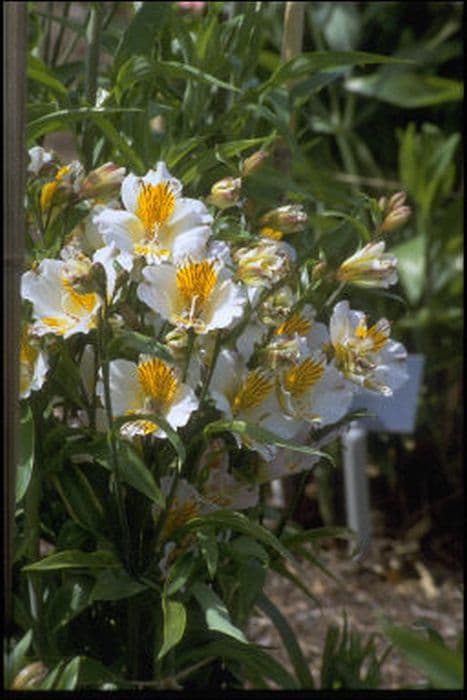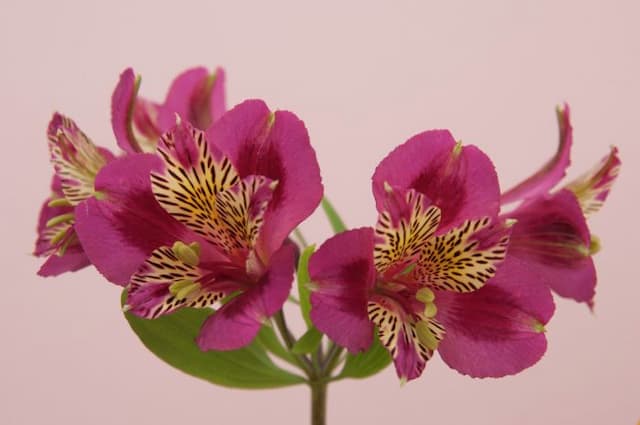Peruvian Lily Alstroemeria H.r.h. Princess Alice = 'Staverpi'
![Peruvian lily [H.R.H. Princess Alice]](/_next/image?url=https%3A%2F%2Fplants-admin.emdemapps.com%2Fimages%2Fplants%2F%2Fimages%2F604b55e81c8b0.png&w=3840&q=75)
ABOUT
Alstroemeria H.r.h. Princess Alice, commonly known as the Peruvian Lily or Lily of the Incas, boasts a striking and colorful appearance. The plant is adorned with lush, lance-shaped green leaves that create a dense backdrop for its showy flowers. The blooms exhibit a remarkable and intricate design, with each flower displaying six petals. These petals are often a blend of pastel and vibrant hues, with a common palette including pinks, yellows, and oranges that may merge into each other or present in distinct sections. The petals of the Peruvian Lily are also known for their unique markings. Many flowers will feature dark speckles or streaks that contrast beautifully against the lighter background color, giving the bloom additional visual interest and texture. The arrangement of the flowers is equally attractive, with multiple blossoms clustered at the top of each stem, creating a lush, bouquet-like display. This elegant plant often blooms with a profusion of flowers that captivate the eye and can add color and life to any garden space or floral arrangement. The Peruvian Lily has a sturdy and upright form, and its flowers are a favorite among gardeners and floral designers for their long-lasting and expressive beauty. This particular variety, with its royal namesake, carries a sense of regal charm and sophistication. It's a truly stunning plant that can capture the attention of any onlooker with its delightful and vivid display.
About this plant
 Names
NamesFamily
Alstroemeriaceae
Synonyms
Peruvian Lily, Lily of the Incas, Parrot Lily
Common names
Alstroemeria 'Staverpi'
 Characteristics
CharacteristicsLife cycle
Perennials
Foliage type
Semi-deciduous
Color of leaves
Green
Flower color
Mixed
Height
2-3 feet (0.6-0.9 meters)
Spread
2 feet (0.6 meters)
Plant type
Herb
Hardiness zones
7
Native area
South America
Benefits
 General Benefits
General Benefits- Decorative Appeal: Alstroemeria, commonly known as Peruvian Lily, features vibrant flowers that enhance aesthetic beauty in gardens and floral arrangements.
- Long-lasting Blooms: Peruvian Lilies are known for their prolonged blooming season, providing color in your garden or home for an extended period.
- Attracts Pollinators: They can attract beneficial pollinators such as bees and butterflies, supporting the local ecosystem.
- Drought Tolerance: Once established, they exhibit moderate drought tolerance, making them suitable for water-efficient landscaping.
- Cutting Flower: The long stems and durability of the flowers make them excellent for cutting and use in bouquets and vases.
- Versatility in Landscaping: Peruvian Lilies can be used for a variety of landscaping needs, including borders, containers, and as mass plantings.
- Low Maintenance: They are relatively low maintenance, requiring minimal care once they are properly established.
 Medical Properties
Medical PropertiesThis plant is not used for medical purposes.
 Air-purifying Qualities
Air-purifying QualitiesThis plant is not specifically known for air purifying qualities.
 Other Uses
Other Uses- Photography: The distinctive flowers of the Alstroemeria, also known as Peruvian Lily or Lily of the Incas, can be used as subjects in macro photography due to their intricate petal patterns and vibrant colors.
- Artistic Inspiration: Artists may draw inspiration from the Peruvian Lily's unique form and color for various art projects, including painting, drawing, and textile design.
- Gastronomy: Although not commonly eaten, the petals of some Alstroemeria species could potentially be used as a decorative edible garnish in high-end culinary presentations.
- Education: The Peruvian Lily can serve as an educational tool in botany classes to illustrate plant biology, hybridization, and horticulture techniques.
- Wedding Decor: Due to their long vase life and attractive appearance, Peruvian Lilies can be used creatively in wedding bouquets, centerpieces, and venue decorations.
- Crafting: The dried flowers of Alstroemeria can be used in crafting, such as in the creation of homemade potpourri or decorative wreaths.
- Color Dye: While not a common use, the pigments in the Peruvian Lily petals could potentially be used to create natural dyes for fabrics or artwork.
- Symbolism: In bouquet language or floriography, Peruvian Lilies can symbolize friendship and devotion, making them suitable for gifts conveying these sentiments.
- Biological Indicator: The growth and health of Alstroemeria plants can be used by gardeners as an indicator of soil quality and environmental conditions in a garden.
- Cultural Festivals: Because of their South American origins, Peruvian Lilies can be used in cultural festival displays to represent the flora of the Andean region.
Interesting Facts
 Feng Shui
Feng ShuiThe Peruvian Lily is not used in Feng Shui practice.
 Zodiac Sign Compitability
Zodiac Sign CompitabilityThe Peruvian Lily is not used in astrology practice.
 Plant Symbolism
Plant Symbolism- Friendship - Alstroemeria, commonly known as the Peruvian Lily or Lily of the Incas, is often associated with strong bonds of friendship due to its lasting nature, symbolizing the enduring connections between people.
- Devotion - The Peruvian Lily is symbolic of mutual support and devotion, reflecting a commitment and loyalty that friends share.
- Wealth - With its multiple blooms and leaves, the Alstroemeria signifies abundance and wealth, conveying a wish for prosperity.
- Good Fortune - The Peruvian Lily is also thought to bring good fortune, making it a popular gift for new ventures or as a token of encouragement.
- Achievement - The intricate and vibrant blooms of the Peruvian Lily stand for achievement and the desire to strive for success.
 Water
WaterFor the Peruvian Lily, water thoroughly once the top inch of soil feels dry, typically once a week, although this may vary depending on climate and season. It's best to water deeply and infrequently to encourage deep root growth. Aim to provide about half a gallon of water for an outdoor plant each time, ensuring even soil moisture but avoiding waterlogging. During hot summers, you may need to water more frequently, while in cooler months or rainier climates, the need to water will be less frequent.
 Light
LightThe Peruvian Lily thrives in bright, indirect light but can also handle full sun in milder climates. The ideal spot would be where the plant receives morning sunlight and afternoon shade, especially in hotter regions, to protect it from intense sun exposure.
 Temperature
TemperaturePeruvian Lilies prefer a climate with temperatures ranging from 65 to 80 degrees Fahrenheit. They can tolerate a minimum temperature of about 24 degrees Fahrenheit but should be protected from frost. During extreme heat, above 90 degrees Fahrenheit, provide shade to prevent stress.
 Pruning
PruningPeruvian Lilies benefit from pruning to remove spent flowers and encourage reblooming. Cut the flowering stems close to the base after blooming to promote new growth. Prune occasionally throughout the growing season, which typically spans from spring to early fall.
 Cleaning
CleaningAs needed
 Soil
SoilPeruvian Lily (Alstroemeria) prefers well-draining soil rich in organic matter with a pH between 6.5 to 7.0. A good mix can be made from equal parts loam, peat, and sand to ensure proper drainage and fertility. Regular amendments with compost or well-rotted manure will benefit the plant's growth and flowering.
 Life cycle
Life cycleAlstroemeria H.r.h. Princess Alice, commonly known as Peruvian Lily 'Staverpi', begins its life cycle as a dormant rhizome or tuberous root, which when planted in early spring, germinates as the soil warms. The plant then progresses to the vegetative stage, producing lance-shaped leaves along its stems as it grows. By mid to late spring, flower stalks emerge, adorned with the plant's characteristic trumpet-shaped, colorful flowers, which can last through the summer and into fall depending on the climate. During its blooming period, the Peruvian Lily attracts pollinators such as bees, which help in the cross-pollination process, essential for seed formation. Once flowering diminishes, the plant will gradually enter a period of senescence in the fall, where above-ground growth dies back, and the plant focuses energy on its underground storage organs. These organs overwinter and enable the Peruvian Lily to regrow the following spring, completing its perennial cycle.
 Propogation
PropogationPropogation time
Spring to early summer
The Alstroemeria, commonly known as Peruvian Lily, can be propagated through several methods, with division being the most popular and effective technique. This is typically done in the spring before the plant starts its active growth or in the fall after the bloom period has ended. To propagate by division, carefully dig up the clumps of tubers, being mindful not to damage them. Wash off any soil and then gently pull apart the tubers, ensuring that each division has at least one or two growth points. The divisions can then be immediately replanted into well-draining soil at a depth of about 6-8 inches (15-20 centimeters), spaced approximately 12-18 inches (30-45 centimeters) apart to allow sufficient room for growth. Water the new plants thoroughly after planting to settle the soil around the tubers. This method allows for a relatively quick establishment and blooming of new plants within the same or the following growing season.






![Peruvian lily [Inca Coral]](/_next/image?url=https%3A%2F%2Fplants-admin.emdemapps.com%2Fimages%2Fplants%2F%2Fimages%2F604b5b79b85ce.png&w=640&q=75)
![Peruvian lily [Inca Exotica]](/_next/image?url=https%3A%2F%2Fplants-admin.emdemapps.com%2Fimages%2Fplants%2F%2Fimages%2F604b5ec0e34a9.png&w=640&q=75)
![Peruvian lily [Inca Milk]](/_next/image?url=https%3A%2F%2Fplants-admin.emdemapps.com%2Fimages%2Fplants%2F%2Fimages%2F604b5f14b0b6a.png&w=640&q=75)
![Peruvian lily [Inticancha Dark Purple]](/_next/image?url=https%3A%2F%2Fplants-admin.emdemapps.com%2Fimages%2Fplants%2F%2Fimages%2F604b5381bb78f.png&w=640&q=75)